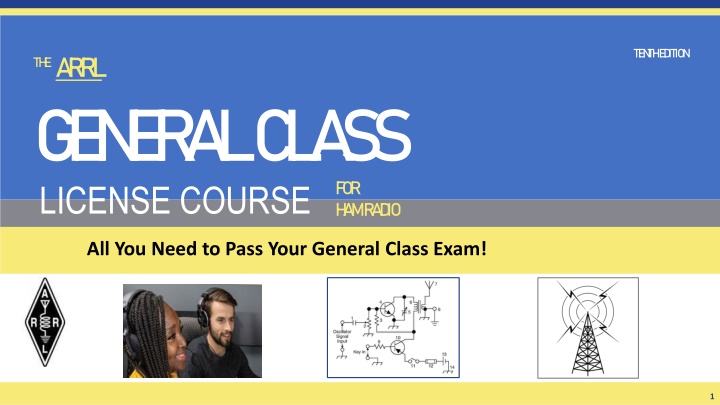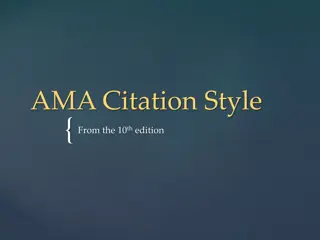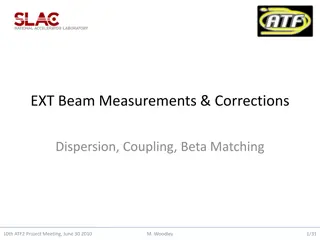
Pass Your General Class Exam with TE.N.TH.E.D.ITION Course
Prepare for your General Class exam with the comprehensive TE.N.TH.E.D.ITION course, covering essential topics such as antennas, dipoles, and ground-planes. Gain valuable insights and resources to help you succeed in obtaining your General Class license for HAM radio. Get ready to ace your exam with confidence! Visit www.arrl.org/shop/Licensing-Education-and-Training for more information.
Download Presentation

Please find below an Image/Link to download the presentation.
The content on the website is provided AS IS for your information and personal use only. It may not be sold, licensed, or shared on other websites without obtaining consent from the author. If you encounter any issues during the download, it is possible that the publisher has removed the file from their server.
You are allowed to download the files provided on this website for personal or commercial use, subject to the condition that they are used lawfully. All files are the property of their respective owners.
The content on the website is provided AS IS for your information and personal use only. It may not be sold, licensed, or shared on other websites without obtaining consent from the author.
E N D
Presentation Transcript
TE N TH E D ITION TH EA RRL G E N E R A L C L A SS LICENSE COURSE FOR H A M R A D IO All You Need to Pass Your General Class Exam! 1
Resource & Reference www.arrl.org/shop/Licensing-Education-and-Training 2
Chapter 7 Part 1 of 2 ARRL General Class Antennas Sections 7.1, 7.2 Dipoles, Ground-planes, Yagi Antennas 3
Section 7.1 Dipoles & Ground-planes Dipoles The most fundamental antenna Straight conductor that is 1 2 wavelength ( /2) long with feed point in the middle (referred to as a doublet) Strongest radiation direction is broadside to its axis in a plane containing the antenna s conductor Weakest radiation is off the ends (see Fig 7.1) Shape of azimuth pattern for a dipole in free space is a figure 8 4
Part A shows the radiation pattern in the plane of a dipole located in free space. The dipole element is located on the line from 270 to 90 degrees in this figure. Part B shows the three-dimensional radiation pattern in all directions around the dipole. Fig 7.1 5
Dipoles (cont.) Dipole is often used as reference antenna for gain measurements Gain measured in dBd Isotropic antenna as the reference, gain is given in dBi Isotropic (theoretical) antenna: radiates equally in all directions Convert dBd to dBi by adding 2.15 dB Convert dBi to dBd by subtracting 2.15 dB Current in half-wave dipole is highest in middle, at ends; voltage along dipole is highest at ends and lowest in middle (Fig 7.2) 6
Fig 7.2 The half-wave dipole at A has its maximum current in the middle and maximum voltage at each end. Feed point impedance is lowest in the middle. At odd harmonics of the fundamental frequency, the dipole s feed point impedance is low at the midpoint once again as shown at B. 7
Dipoles (cont.) Impedance increases as feed point is moved away from the center; several thousand ohms at the ends Example: End-fed half-wave (EFHW) antenna popular for portable operating (lightweight and easy to install) EFHW is just a half-wave dipole fed at one end Calculating free-space length In free space, 1 2 wavelength in feet equals 492 divided by frequency in MHz CAUTION: You will generally find that the length will be SHORTER than the free- space wavelength calculation. However, exam questions won t require you to answer the exceptions. Just be aware that wire thickness and height above ground influence the resonant length. Length (ft) = 492 / frequency (MHz) 8
Example: What is the approximate length in feet of a 1/2-wave dipole resonant at 3.550 MHz? ????????? (???) = 492 492 ???? ????? ????? = 3.55 = 139 ft Remember, the actual antenna will be a little shorter than this. But, build it to the calculation, and use your tuner to tell you if it needs trimmed. Ideally, you want SWR as close to 1:1 as you can get without tuning. 9
Example: What is the approximate length in feet of a 12-wave dipole for 14.250 MHz? 492 492 14.25 = 34.5 ft ???? ????? ????? = ????????? (???) = 10
Dipoles (cont.) Center-fed dipoles are easiest to use on the band for which they are resonant The feed point impedance is a good match for 50 or 75- coax and for coax on odd multiples of the fundamental frequency A dipole doesn t need to be straight to be effective Dipole can be supported in the center where the feed line can be conveniently attached This configuration is called an inverted V As long as the legs of the dipole form an angle of 90 degrees or more, the inverted V is nearly as effective as a horizontally installed dipole 11
Ground Plane Verticals The ground-plane antenna is one-half of a dipole with the missing portion made up by an electrical mirror, called the ground plane Made from sheet metal or a screen of radial wires Basic ground-plane is 1 4-wavelength ( /4) long with feed point at the junction of antenna and ground plane For HF ground-plane antennas at ground level, radial wires are laid on surface of ground or buried within a few inches of surface 12
Ground Plane Verticals (cont.) Ground-planes are called verticalsbecause that s the usual way of constructing and installing them Ground-plane radiates best broadside to its axis If installed vertically, the ground-plane antenna s pattern is omnidirectional, uniform in all azimuth angles or directions Useful for VHF and UHF mobile/portable communications where signals may come from any direction 13
Fig 7.3: Ground Plane The ground plane, whether made of solid metal or radial wires, creates an electrical mirror image of the 1 4-wavelength antenna. This creates the electrical equivalent of a dipole antenna. The feed point impedance at the base of the ideal ground-plane is 35 , half of a complete dipole s impedance, because only half of the antenna is physically there and able to radiate energy. 14
Fig 7.4: Ground Plane The feed point impedance of a ground-plane antenna with radials perpendicular to the antenna is approximately 35 , resulting in a 1.4:1 SWR with 50- coaxial cable. Drooping or sloping the radials gradually raises the feed point impedance until, with the radials drooped so far as to become the other half of a dipole, feed point impedance becomes 72 . A 50- feed point is reached with radials drooping approximately 45 degrees. 15
Ground Planes (cont.) A droop angle between 30 and 45 degrees as shown in Fig 7.4 results in the feed point impedance increasing to approx. 50 (matches coaxial cable) As with the dipole, it is not useful to provide a one-size-fits-all formula for length of a ground-plane antenna Since the ground-plane is one-half the size of a dipole, start with one-half the free-space length (246 / f in MHz) and be prepared to trim the antenna s length 16
Example: What is the approximate length in feet of a 14-wave monopole antenna cut for 28.5 MHz? 246 ? 246 28.5= 8.6 ?? ???? ????? ????? = = 17
Mobile HF Antennas Mobile HF antennas are often some form of ground-plane Most popular is the vertically-oriented whip A full-sized /4 mobile whip is not feasible on bands below 28 and 24 MHz (too long) Loading techniques are used to increase their electrical length Loading coils: A coil added at base or somewhere along the length Capacitance hats: Spokes or a wheel-shaped structure is added near the top of the antenna Linear loading: Part of the antenna is folded back on itself 18
Mobile HF Antennas (cont.) Another common feature on mobile whips is corona ball at the tip Does add a small amount of loading capacitance, but primary function is to eliminate high-voltage discharges from the sharp tip of the antenna while transmitting A loaded antenna is not as efficient as a full-sized straight whip and will have a small operating bandwidth without retuning The screwdriver antenna design a whip with an adjustable loading coil at the base (changes the inductance) has gained popularity for HF mobile operation as a good compromise between performance and convenience 19
Effects of Ground A dipole s feed point impedance and radiation pattern are both affected by its physical height above ground Feed point impedance is affected because the electrical image is electrically reversed from the actual dipole As the image and antenna get closer together, the actual antenna begins to be shorted out by the image Below 1 4 wavelength in height, dipole s feed point impedance steadily decreases until it is close to at ground level 20
Fig 7.5 The feed point impedance of a horizontal dipole over perfect ground varies dramatically with height. At ground level, the antenna is effectively shorted out by its electrical image. As the antenna is raised, the impedance gradually approaches the 72- feed point impedance of a dipole in free space. Above 1 4 , the impedance varies as suggested by Figure 7.5, eventually reaching a stable value at a height of several wavelengths. 21
Effects of Ground (cont.) Height above ground also affects radiation patterns because of reflection of the antenna s radiated energy by the ground The direct and reflected signals take different amounts of time to travel to the receiving antenna so they can add together, cancel each other, or any combination in between Fig 7.6 shows what happens when a dipole is raised in steps from a very low height to more than one wavelength above ground 22
Fig 7.6 As a low dipole starting at 1 8 wavelength above ground is raised, the effects of its electrical ground image cause the elevation pattern to flatten out. At multiples of 1/2 wavelength in height, the pattern has a null in the vertical direction because the direct and reflected signals cancel. At heights below 1 2 wavelength, the dipole s pattern is almost omnidirectional and is maximum straight up. 23
NVIS Propagation Near-vertical incidence sky-wave propagation are signals that go straight up Signals radiated at high vertical angles on low frequencies are usually reflected back to the ground over a wide area, ensuring good communication Horizontal dipoles from 1 10 to 1 4 wavelength high produce an omnidirectional, high-angle pattern ideal for NVIS use Used by many public service teams 24
Effects of Ground (cont.) Polarization also affects the amount of signal that is lost from the resistance of the ground Radio waves reflecting from the ground have lower losses when the polarization of the wave is parallel to the ground (i.e., horizontally polarized) Because the radiation pattern is made up of reflected waves combining with direct waves that are not reflected, lower reflection loss results in stronger maximum signal strength 25
Antenna Terms Feed point impedance: Ratio of RF voltage to current at an antenna s feed point Resonant: When antenna feed point impedance is completely resistive with no reactance Radiation pattern: Graph of antenna s signal strength in every direction or at every vertical angle Azimuthal pattern: Shows signal strength in horizontal directions Elevation pattern: Shows signal strength in vertical directions Lobes: Regions in the radiation pattern where antenna is radiating a signal Nulls: Points at which radiation is at a minimum between lobes Isotropic antenna: Radiates equally in every possible direction (theoretical only) Omnidirectional antenna: Radiates a signal equally in every horizontal direction Directional antenna: Radiates preferentially in one or more directions Gain: Concentrating transmitted or received signals in a specific direction Front-to-back ratio: Ratio of gain in the preferred or forward direction to the opposite direction Front-to-side ratio: Ratio of gain in the preferred or forward direction to directions at right angles 26
What is the purpose of a capacitance hat on a mobile antenna? A. To increase the power handling capacity of a whip antenna B. To reduce radiation resistance C. To electrically lengthen a physically short antenna D. To lower the radiation angle G4E01 (C) Page 7-6 28
What is the purpose of a corona ball on an HF mobile antenna? A. To narrow the operating bandwidth of the antenna B. To increase the Q of the antenna C. To reduce the chance of damage if the antenna should strike an object D. To reduce RF voltage discharge from the tip of the antenna while transmitting G4E02 (D) Page 7-6 29
What is one disadvantage of using a shortened mobile antenna as opposed to a full-size antenna? A. Short antennas are more likely to cause distortion of transmitted signals B. Q of the antenna will be very low C. Operating bandwidth may be very limited D. Harmonic radiation may increase G4E06 (C) Page 7-6 30
Which of the following is a common way to adjust the feed point impedance of an elevated quarter-wave ground-plane vertical antenna to be approximately 50 ohms? A. Slope the radials upward B. Slope the radials downward C. Lengthen the radials beyond one wavelength D. Coil the radials G9B02 (B) Page 7-5 31
Which of the following best describes the radiation pattern of a quarter-wave ground-plane vertical antenna? A. Bi-directional in azimuth B. Isotropic C. Hemispherical D. Omnidirectional in azimuth G9B03 (D) Page 7-5 32
What is the radiation pattern of a dipole antenna in free space in a plane containing the conductor? A. It is a figure-eight at right angles to the antenna B. It is a figure-eight off both ends of the antenna C. It is a circle (equal radiation in all directions) D. It has a pair of lobes on one side of the antenna and a single lobe on the other side G9B04 (A) Page 7-3 33
How does antenna height affect the azimuthal radiation pattern of a horizontal dipole HF antenna at elevation angles higher than about 45 degrees? A. If the antenna is too high, the pattern becomes unpredictable B. Antenna height has no effect on the pattern C. If the antenna is less than 1/2 wavelength high, the azimuthal pattern is almost omnidirectional D. If the antenna is less than 1/2 wavelength high, radiation off the ends of the wire is eliminated G9B05 (C) Page 7-7 34
Where should the radial wires of a ground-mounted vertical antenna system be placed? A. As high as possible above the ground B. Parallel to the antenna element C. On the surface or buried a few inches below the ground D. At the center of the antenna G9B06 (C) Page 7-5 35
How does the feed point impedance of a horizontal 1/2 wave dipole antenna change as the antenna height is reduced to 1/10 wavelength above ground? A. It steadily increases B. It steadily decreases C. It peaks at about 1/8 wavelength above ground D. It is unaffected by the height above ground G9B07 (B) Page 7-6 36
How does the feed point impedance of a 1/2 wave dipole change as the feed point is moved from the center toward the ends? A. It steadily increases B. It steadily decreases C. It peaks at about 1/8 wavelength from the end D. It is unaffected by the location of the feed point G9B08 (A) Page 7-3 37
Which of the following is an advantage of a horizontally polarized as compared to a vertically polarized HF antenna? A. Lower ground losses B. Lower feed point impedance C. Shorter radials D. Lower radiation resistance G9B09 (A) Page 7-7 38
What is the approximate length for a 1/2 wave dipole antenna cut for 14.250 MHz? A. 8 feet Reminder: Length of wave dipole is 492 / f in MHz B. 16 feet C. 24 feet D. 33 feet Length = 492 / 14.25 = 34.5 feet No exact match, so closest choice is D. G9B10 (D) Page 7-4 39
What is the approximate length for a 1/2 wave dipole antenna cut for 3.550 MHz? A. 42 feet Reminder: Length of wave dipole is 492 / f in MHz B. 84 feet C. 132 feet D. 263 feet Length = 492 / 3.55 = 139 feet No exact match, so closest choice is C. G9B11 (C) Page 7-4 40
What is the approximate length for a 1/4 wave vertical antenna cut for 28.5 MHz? A. 8 feet Reminder: Length of wave dipole is 492 / f in MHz So, wave dipole is half that 246 / f B. 11 feet C. 16 feet D. 21 feet Length = 246 / f = 246 / 28.5 = 8.6 feet No exact match, so closest choice is A. G9B12 (A) Page 7-5 41
How does antenna gain stated in dBi compare to gain stated in dBd for the same antenna? A. Gain in dBi is 2.15 dB lower B. Gain in dBi is 2.15 dB higher C. Gain in dBd is 1.25 dBd lower D. Gain in dBd is 1.25 dBd higher G9C04 (B) Page 7-3 42
Which of the following antenna types will be most effective as a near vertical incidence skywave (NVIS) antenna for short-skip communications on 40 meters during the day? A. A horizontal dipole placed between 1/10 and 1/4 wavelength above the ground B. A vertical antenna placed between 1/4 and 1/2 wavelength above the ground C. A horizontal dipole placed at approximately 1/2 wavelength above the ground D. A vertical dipole placed at approximately 1/2 wavelength above the ground G9D01 (A) Page 7-7 43
What is the feed point impedance of an end-fed half-wave antenna? A. Very low B. Approximately 50 ohms C. Approximately 300 ohms D. Very high G9D02 (D) Page 7-4 44
How does a screwdriver mobile antenna adjust its feed point impedance? A. By varying its body capacitance B. By varying the base loading inductance C. By extending and retracting the whip D. By deploying a capacitance hat G9D08 (B) Page 7-6 45
What is the common name of a dipole with a single central support? A. Inverted V B. Inverted L C. Sloper D. Lazy H G9D12 (A) Page 7-4 46
Section 7.2 Yagi/Directional Antenna Basics Directional antennas create gain as well as reject interference and noise from other than the desired direction By aiming your antenna in the direction shown on the azimuthal projection map, you will be beaming your signal directly at the other station Dipole, ground-plane, and random wire antennas use a single radiating element An array antenna uses two or more elements to create maximum field strength in a specific direction, called the main lobe or major lobe of the radiation pattern 47
Directional Antennas (cont.) Two types of arrays: driven and parasitic Driven array: all of the antenna elements are connected to the transmitter and are called driven elements Parasitic array: one or more of the elements are not connected to the feed line but influence the antenna s pattern by interacting with the radiated energy from the driven element(s) Whether an array is driven or parasitic, its radiation pattern is determined by constructive and destructive interference If in phase, they will reinforce each other If out of phase, they will cancel 48
Yagi Structure Most popular of all directional antennas because of simple construction & good performance Yagi is a parasitic array with a single driven element and at least one parasitic element The driven element (DE) is a resonant dipole, approximately 1 2 wavelength long Parasitic elements placed in the direction of maximum gain are called directors and are slightly shorter than the driven element Parasitic elements in the direction of minimum gain are called reflectors and are slightly longer than the driven element The front-to-back ratio is the ratio of signal strength at the peak of the radiation pattern s major lobe to that in exactly the opposite direction 49
Figure 7.8 Two Element Yagi Two-element Yagi antenna with a single parasitic element. At A the parasitic element acts as a director, and at B as a reflector. The arrows show the direction of maximum radiation. 50






















